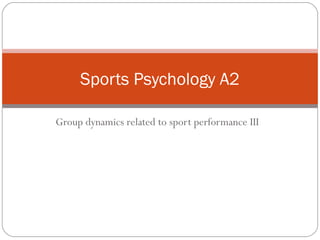
Group dynamics III
- 1. Group dynamics related to sport performance III Sports Psychology A2
- 2. Topic aims: By the end of this topic you should be able to: 1. Describe the nature of a group/team (mutual awareness, interaction, common goal). 2. Demonstrate knowledge and understanding of Steiner’s model of group performance (awareness of problems associated with productivity of a group/team). 3. Demonstrate knowledge and understanding of motivational factors(social loafing); coordination/cooperation factors (Ringelmann effect) and explain the negative influences on behaviour that cause dysfunctional behaviour and avoidance of an active and healthy lifestyle. 4. Explain the factors factors affecting the formation and development of a cohesive group/team.
- 3. Formation and development of a cohesive group/team Group Dynamics: Process by which a group is constantly developing and changing when interaction takes place. When indentifying a group or sporting team; we look at whether they are displaying the 6 I’s: Interaction (communication over a period of time) Interdependence (person and task to achieve common goal) Interpersonal relationships (mutual attraction) Identical goals/norms/values Identity (perception of groups existence) Independence A coach working to develop the six I’s when bringing together individuals would have to work over a considerable period of time in order to get the best performance.
- 4. Tuckman (1965): Model of group formation Tuckman suggested that in order for a group to become a ‘strong’ team (displaying 6 I’s) they have to go through four key progressive stages of development. The stages are: storming/performing/norming/forming. Can you identify these stages in the groups you are observing? Can you place the stages in the correct order? Provide a brief explanation of each stage.
- 5. Tuckman (1965): Model of group formation TASK 1: Use page 168 in your text book to write notes on each of Tuckman’s four key stages of group formation. Draw out key points and use bullet points to highlight. TASK 2: As the coach of a newly forming team. What strategies might you use to try to help new members of the team move successfully through the ‘forming’ stage? TASK 3: As the coach of a newly forming team. What strategies might you use to try to reduce the effects encountered in the ‘storming stage’? Think about... Leadership: what type of style would you take on to overcome the problems that may arise in the storming stage? What characteristics would you need?
- 6. Structures and role within groups and teams A ‘role’ is the specific behaviour expected of a person occupying a certain position in the group’s structure. Role’s begin to develop during the ‘forming’ stage of group/team formation. 1. Formal roles – 2. Formal task or performance roles – 3. Informal roles –
- 7. Structures and role within groups and teams A ‘role’ is the specific behaviour expected of a person occupying a certain position in the group’s structure. Role’s begin to develop during the ‘forming’ stage of group/team formation. 1. Formal roles – teacher, coach, team captain. 2. Formal task or performance roles – 3. Informal roles –
- 8. Structures and role within groups and teams A ‘role’ is the specific behaviour expected of a person occupying a certain position in the group’s structure. Role’s begin to develop during the ‘forming’ stage of group/team formation. 1. Formal roles – teacher, coach, team captain. 2. Formal task or performance roles – striker in football/hockey, goalkeeper, penalty taker (hockey/football), goal kicker (rugby), goal shooter (netball). 3. Informal roles –
- 9. Structures and role’s within groups and teams A ‘role’ is the specific behaviour expected of a person occupying a certain position in the group’s structure. Role’s begin to develop during the ‘forming’ stage of group/team formation. 1. Formal roles – teacher, coach, team captain. 2. Formal task or performance roles – striker in football/hockey, goalkeeper, penalty taker (hockey/football), goal kicker (rugby), goal shooter (netball). 3. Informal roles – team diplomat/social roles, team comedian/joker, team ‘hardman’ or ‘stopper’.
- 10. Structures and role’s within groups and teams In order for ‘role’ to be taken on successfully it is important that: The performer is aware or their role (role clarity) The performer is willing and accepts it and can function in that role (role acceptability) The performer understands the role The coach/teacher sets clear and specific goals related to the role.
- 11. Structures and role’s within groups and teams TASK 4: Answer the following questions on a separate sheet of paper using your textbook as a guide. 1. Explain the term ‘group norms’. 2. Provide two examples of ‘groups norms’ within a sporting situation. 3. How can a coach ensure that members of the team conform to the ‘norms’ they have put in place. 4. What are the positive impacts of a coach making the ‘group norms’ clear and ensuring players adhere to them. 5. What are the possible negative effects of a coach placing ‘group norms’ on a teams behaviour? Use a sporting example to illustrate you answer.
- 12. Homework – Thursday 2nd December Read the Sports Psychology article ‘Team Sports: Team cohesion and success: is there really a link?’ by Raphael Brandon. Answer the questions below based on the article. 1. Does a team have to display high levels of cohesion to be successful? Illustrate your answer using a sporting example. 2. Why is early research in to the link between team cohesion and success disputed by researchers led by Albert Carron? 3. How does ‘GEQ’ over come early problems with validity of research results. 4. What did the research team led by Albert Carron conclude?
- 13. Homework – Due Thursday 2nd Dec. 5. What did research findings Carron et al’s later study in to the success of basketball and football teams suggest? 6. How can coach’s/teacher’s assess team cohesion? 7. What have the studies suggested that coach’s/teachers should aim to develop in their teams to aid successful performance?